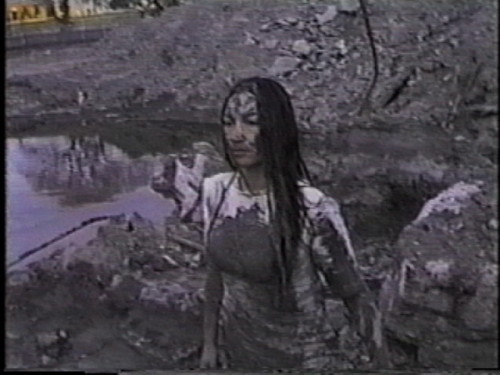
toxic soil is a site-specific live artwork performed for the camera in an empty lot adjacent to my 97/98 studio on River St. in Toronto. This piece of land was once a small wilderness in the heart of the downtown eastside. My own little piece of bush. It was abundant with growth. Many kinds of wild plants flourished there. Small trees shaded my windows, and in the middle of the lot was a beautiful maple. I cherished this place. I spent time in it, and it began to inspire ideas for sculpture and live artworks.
I woke one morning to the sound of chainsaws. The whole building was shaking from the vibrations of a backhoe. I looked outside at a display of carnage, epitomized by the severed limbs of the maple. This attack on my "wilderness" continued for days, culminating in the digging of two huge holes at one end of the lot. There were also days of inactivity, the machines sitting quiet. During these times I was struck by the changed view, now a still, urban wasteland of oily ponds and piles of exposed earth and structural rubble.
Apparently the soil on the lot was toxic, and had to be removed and replaced before development could continue. Thus the large holes, now filled with water.
I was struck not only by the barrenness of the image, but by the absurdity of the whole procedure. And I was of coarse disturbed by the destruction of the life that had teemed there. Yet the irony of my upset, given that for every other developed lot in the city, including the one I called home, a similar process had to have happened, was not lost on me.
In response to all this, I decided to go ahead and do a site-specific work on the changed lot. I had only some basic actions in mind, and a desire to continue a practice I had used in some previous live works – the use of a white wedding gown. Beyond that I wanted everything to be intuitive – a direct response to the environment.
The white dress had become a recurring presence in my work after my ‘unearthing’ of Bridget – an ancient Celtic goddess of fire, creativity, and certain animals sometimes present in my dreams. When the Christians suppressed the Pagans, Bridget was too powerful to obliterate, so they appropriated her, making her a saint, and changing her name. She became St.Bride. Once attended only by priestesses, Bridget’s sacred sites and eternally burning fire were now cared for by nuns. Repressed and sometimes even murdered, they nonetheless preserved her rites for as long as they could. Imbolc, the goddess’s early spring fertility festival, was eventually to become Candlemas, the flames mere remnants of her previous fire. And thus, as far as I can tell, came the origin of the word bride.
Wearing a wedding dress became for me a symbol of the ultimate marriage - especially in relation to a woman’s potentially ‘dangerous’ creative acts – the one with the Creator. It also referred to the survival of what is precious, especially in the face of great oppression. Bridget became for me a positive bridge between the often dispirit cultures of my own mixed-blood heritage.
At the same time, the dress, and the activities performed in it, addressed feelings I had about myself in regards to some difficult personal relationships – and the struggles to not only to survive, but also make sense of them in a world that is ‘toxic’, on so many levels. I had at times come to feel that I was as ‘unusable’ as this urban scourge. In the face of this it seemed pertinent to remember, and embrace, how all of our relationships are underlined, and ultimately defined by, our relationship to the earth. How the external toxicity is always mirrored internally, and visa versa. Amongst other things, toxic soil is a cathartic return to the land, both symbolic and literal. I wanted to embrace the landscape, even become it, no matter what state she was in, as an affirmation of the necessity of maintaining those fundamental relationships; with the earth, ourselves, the spiritual – no matter how difficult or "dirty" they may become.
Rental and Sales
Single Screening Rental | $190.00 |
Educational Purchase DVD (Bluray +$15) | $260.00 |
5 Year Educational Streaming License, Digital File with DVD Circulation Copy | $550.00 |
Gallery Exhibition and Installation, complete Media Request form for quote | |
Institutional Archival Acquisition, complete Media Request form for quote |
Curators and programmers, please contact distribution@vtape.org to receive a login and password to preview Vtape titles online.
Screening and exhibition rentals and archival acquisitions include public performance rights; educational purchases or licenses include rights for classroom screenings and library circulation. When placing an order the customer agrees to our general online terms and conditions. Payment (or a purchase order number) and a signed licensing agreement must be received before media can be shipped to the client.
